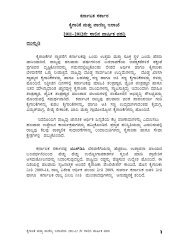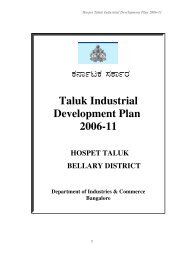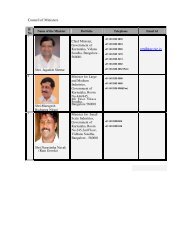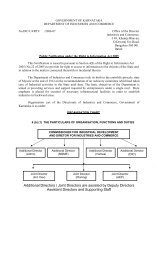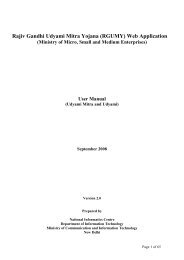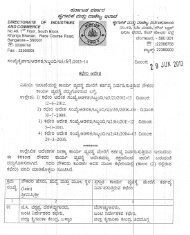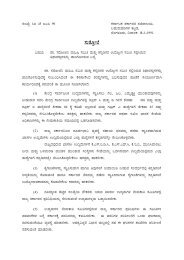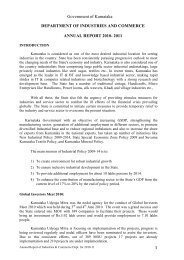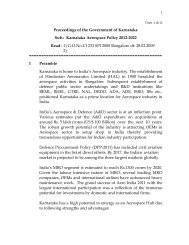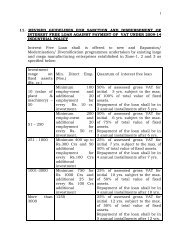Word Pro - DIDP H.B.Halli - Karnataka industry
Word Pro - DIDP H.B.Halli - Karnataka industry
Word Pro - DIDP H.B.Halli - Karnataka industry
You also want an ePaper? Increase the reach of your titles
YUMPU automatically turns print PDFs into web optimized ePapers that Google loves.
H.B.<strong>Halli</strong> Taluk Industrial Development Plan 2006-11N®w¯ÁhN® š®N¯ÁŠ®Taluk IndustrialDevelopment Plan2006-11H.B HALLI TALUKBELLARY DISTRICTDepartment of Industries & CommerceBangalore
H.B.<strong>Halli</strong> Taluk Industrial Development Plan 2006-11Sr.No.Tyre retreadingSub totalSector / Sub-sector / ActivityUnits273Fin.Outlay(Rs lakh)25.5135.95Emp.Generated20913VElectrical/Electronics & Computer BasedInds.Battery charging/ servicingInvertors upto 50 kvaVoltage StabilizersEmergency lampsDTP CentresElec.Repairs/ motor rewinding55544139.1810.8810.885.157.7120.05351530121665Sub total3663.85173VIMineral based and building materialproductsHollow concrete blocksJelly crushingSoil Cement BlocksTable moulded bricksCement / Flyash BricksMosaic tilesSub total155101139.7587.44.459.5020131.115753020010150VIILivestock based productsCattle / Poultry feedDressed Broiler chiken unitSub total9413107.85.96113.7610812120VIIIMechanical based productsDiesel Engine servicingSteel fabrication & furnitureBarbed wireAgricultural implementsGeneral EngineeringSub total784155396.67124.1925.47138.4515.37310.152896167525240IXTourism related projectsMotelsMini busesSub total741112.0922.8734.96351651XRural ArtisansStone carvingCarpentryGoldsmithyPottery/ Terracota articlesOther artisans (tailoring, laundry, barbers etc.)51655261.8525.514.734.4516.610801025130BalcksmithySoft toysSub total111211891065.15128.2955605915XISRTOAuto RikshawMini trucks401542.8228.0340455
H.B.<strong>Halli</strong> Taluk Industrial Development Plan 2006-11Chapter 3Taluk at a Glance3.1 Hagaribommanahalli (H B <strong>Halli</strong>) taluk is the headquarters town of the taluk of the samename at a distance of 110 kms from Bellary city. Incidentally this is only taluk with no urbanareas in its jurisdiction in the state. A number of families from the villages submerged in theTungabadhra project have been rehabilitated here. HB<strong>Halli</strong> taluk occupies 5 th place in areaand last place in population among seven taluks.The geographical area of the taluk is 976sq.km. and population is 159886 as per 2001 census.This accounts for 8 p.c. of district’spopulation and its area accounts for 11.50 p.c.Sr.No.1(i)(ii)(iii)(iv)(v)(vi)(vii)(viii)2(i)(ii)(iii)(iv)(v)ItemPopulationTotalRuralUrbanMaleFemaleSC populationST populationDensity in populationLiteracyTotalMaleFemaleUrbanRuralUnitsLakh""""""persons persq.kmthousands""""Data1.601.60-0.810.790.300.22979774730-773.2 Administrative set upH.B.<strong>Halli</strong> comes under the administrative jurisdiction of Hospet revenue sub-division with 4 RI circles. The taluk is divided into four Hoblis. It has 53 villages, 22 Gram Panchayats.3.3 PhysiographyThe taluk is bounded on the north by the Koppal district on the south by Kudligi taluk,on theeast by the Hospet taluk and on the west by Hadagali taluk. The Bellary district is situatedbetween 14 degrees 30’ and 15 degrees 50’ north latitude and 77 degrees 40’ East longitude.The district is situated in a semi-arid zone. The geographical location is at 1512 ft. Heightfrom the main sea level. The western parts of the taluk is hilly with iron deposits.3.4 Soil Conditions & Topographical FeaturesThe Bellary district consists of archern complex composed of crystalline schist’ epidorities,granites and later granites. The soil content of the taluk is black cotton with red loamy. Theriver Cikkahagari flows in the taluk and a dam is constructed Malvi village for irrigationpurpose.3.5 Seasonal & Climatic ConditionsThe Bellary district falls under semi-arid zone with dry climate. The temperature range frommin. 13 degrees Celsius during December to a maximum of 44 degrees Celsius in April and7
H.B.<strong>Halli</strong> Taluk Industrial Development Plan 2006-11May. The taluk is known for its hot summer and a dry weather persists for a major part of theyear. Average rainfall for the taluk is about 554.5 mm per annum, which precipitates in about36 rainy days. Usually August and September months get maximum rainfall.3.6 Land use Pattern:The current pattern of land utilization is as follows:Land UseForestsBarrenNon agricultureCultivable wastePermanent pastureTrees and GrovesCurrent fallowNet area sownTotal geographical areaArea sown more than onceArea (ha)448251591998020581108105198684483997599110853.7 IrrigationThe net irrigated area constitute only 16820 hec. (32 p.c.).The main source of irrigation isSl.no.ParticularsArea (hec.)Percent1Malvi <strong>Pro</strong>ject288717.162Lift Irrigation340820.263Tanks14918.864Wells/Borewells903453.72Total area under irrigation16820100.003.8 Predominant Economic Activities prevalent in the taluk3.8.1 Agricultural sectorAgriculture contributes major portion of the income of the taluk. The major crops grown aremaize, jowar, bajra, sunflower, groundnut and cotton. Though the productivity has shown adeclining trend in the last few years, performance is better than the state average in terms ofproduction and yield with reference to paddy, pulses, jowar and cotton. Major horticulturalcrops grown in the district are chillies, coriander, pomegranate, mango, fig, and coconut.3.8.2. Industrial Sector:H.B.<strong>Halli</strong> taluk is another taluk in the district where industrialisation is making progress atsnail’s pace. In this taluk there are 869 industrial units with an investment of Rs. 746.28lakh. These units provide employment to 3141 persons. There are 1085 Rural artisans whoseactivity comprises of Carpentry, Blacksmith, Barbers, Goldsmith, Pottery, Cotton weaving,Mat weaving and Mirror Embroidery.8
H.B.<strong>Halli</strong> Taluk Industrial Development Plan 2006-11Chapter 4Resource base of the taluk4.1 Agriculture :Around 60% of the population depends on Agricultural activity, rice is the staple food. Intotal 57% of the land is utilised for the agricultural activity. The main crops in H.B.<strong>Halli</strong> Talukare as under :Sl.No. Name of thecropSown area during2005-06 (in ha.)1 Paddy3,2302 Jowar8,3353 Maize16,4704 Pulses4,8055 Groundnut7,0656 Sunflower12,0267 Cotton2,2404.2 Horticulture :<strong>Pro</strong>duction of Horticultural crops in H.B.<strong>Halli</strong> Taluk as on 31.03.2005 is as under :Sr.No.IIIIIIIVVVI1234123412312345678121Name of the cropFruit CropsMangoBananaSapotaGuavaVegetable CropsTomato (Rabi &Kharif)CucumberBrinjalOnion Kharif & RabiSpicesTamarindDry ChilliCorianderOther Horti CropsLadies FingerRadishCluster BeansDrumstick(lakh sticks)Water melonCoconut (lakh nuts)Oil PalmBetelvine(lakh leaves)FlowersJasmine flowerMari GoldMedicinal PlantsOcimmum(Tulasi)Area (Ha.)1172960107460285461565082452854312024662101994612<strong>Pro</strong>duction(M.Ton)1,7557257202501,2691,50084011,894601,300414501404326280024.65112.1259436836yield/ha.1525122518253020420.510582400.130.12683Value (Rs.lakhs)263.2521.7521.605.0035.7445.0016.80834.484.80260.006.1513.501.404.3215.5032.0049.202.041.2189.1018.4018.004.3 Forest4482 ha. or 5% of the area is covered by forest. The activities that can be taken up in theforest area are Bee keeping, Basket making, Manufacture of bags from natural fibres, ropeweaving, collection of minor forest produce, Agarbatti making, Organic farming, Furnitureshop, neem oil/cake manufacturing, Extraction of oil from aromatic plants etc.10
H.B.<strong>Halli</strong> Taluk Industrial Development Plan 2006-114.4 Animal HusbandryAnimal Husbandry is the main allied activity next to Agriculture in H.B.<strong>Halli</strong> Taluk.(i)(ii)(iii)(iv)(v)(vi)Indigenous cattleCross BreedBuffaloesIndigenous sheepGoatsPoultryno.no.no.no.nono38,6881,97816,83542,21825,983480,903Dairy and Sheep/goat rearing are the main activities in the taluk. Dairy developmentactivities in the district are carried out as supplementary activities. The per capitaavailability of milk in the district is 170 gm/day as against the normal requirement at aminimum of 240 gm per day as per Indian Council of Medical Research (ICMR). Raichur-BellaryMilk Union (RBMU) covers Raichur, Koppal and Bellary districts. It has created infrastructuresupport to suit its requirements. The milk production in H.B.<strong>Halli</strong> taluk during 2005-06 was15900 LPD. In H.B.<strong>Halli</strong> taluk, there are 3 Layer farms with daily egg production of 25000.4.5 FisheriesFisheries is one of the important sectors in the socio-economic set up of Bellary district. Itprovides animal protein to population, generates large-scale employment and earns valuableforeign exchange. Fish farming is a traditional activity as the district is endowed with freshwater resources consisting of tanks, reservoirs, rivers, canals and ponds. There is a goodscope for inland fisheries, particularly pond fisheries, tank and riverine fisheries. There are22 irrigation tanks in the taluk. The fishermen population in H.B.<strong>Halli</strong> taluk is 5010. The totalfish production in the taluk during 2005-06 was estimated to be around 596.70 ton. During thepast five years , the construction of fish ponds in Bellary district was encouraging. As on31.3.2005, there are 9 fish ponds in the taluk.4.6 Human ResourceThe details of educational institutions in Hadagali taluk are indicated below.Educational InstitutionsPrimary SchoolsHigh SchoolsPre-universityDegree CollegesNumber ofinstitutions1452851No. of students29,0865,7151,203320Classification of workers:(i) Cultivatorsthousands 22(ii) Agricultural labourers"36(iii) Workers in household<strong>industry</strong>"2(iv) Other workers"12(v) Total"72As per 2001 census, 801369 constituting 40% of the total population are main workers ofwhich 30% are agriculturists, 34% agriculture labourers and the remaining 36% are otherworkers. Of the total main workers, 34% are female workers. More than 68360 are registeredfor employment with the Employment Exchange in the district as at the end of March 2005,out of which 4785 are from H.B.<strong>Halli</strong> taluk. CEDOK, GTTC, SIRD, RUDSETI, Chitradurgaorganizes EDPs, Management Development <strong>Pro</strong>grammes and awareness creating/Skill11
H.B.<strong>Halli</strong> Taluk Industrial Development Plan 2006-11development programmes with a view to motivate rural youth to establish their own SSI units.The following table shows that existing manpower which is not sufficient to meet thedemands of the existing and implementing medium and large scale industries.Sr.No.12345678910ParticularsDegree holdersDiploma holdersITIStenos & TypistsSSLCPUCDriving license holdersBelow SSLCOthersTotal registeredTotal348803311211,6886921451,0431,0215,46912
H.B.<strong>Halli</strong> Taluk Industrial Development Plan 2006-11Chapter 5:Infrastructural facilities and new developmentsThe district fares fairly well under some of the infrastructure indicators such as Electricity,Irrigation, Transportation, Water supply, education, and agricultural markets where theranking of the district is better than the State average. Infrastructure facilities act ascatalysts in the development. In 1995, the GOI set up Rural Infrastructure Development Fund(RIDF) with NABARD for sanctioning loans to State Governments for development of ruralinfrastructure. 465 projects with an outlay of Rs.88.15 crore and RIDF loan of Rs.77.22 croresanctioned by NABARD for the district covering mainly rural roads and bridges,Minor Irrigationprojects, recharging of ground water structures, , anganawadi centres, primary andsecondary schools, rural markets, godowns. District offers scope for infrastructure projects inminor irrigation sector to increase irrigation facilities, improvements to rural roads forall-weather connectivity, development of infrastructure facilities such as rural drinking watersupply, health service projects, creation of water recharge structures, rain water harvestingstructures etc.5.2 PowerIn the taluk, there are 4014 distribution lines per 1000 sq.km and 140 electric connections per1000 population. Per capita power consumption in industries is 6799 kw per annum whereasper capita consumption for all users is 2238 kw.5.3 WaterThe position of drinking water facility in the taluk is given below.Rural Drinking Water1Fluoride affected villagesNumber282BorewellsNumber3093Mini Water Supply schemesNumber1154Piped Water Supply schemesNumber735.4 Road and Rail connectivityThe rail and road connectivity of the taluk are indicated below:1(i)(ii)2(i)(ii)(iii)(iv)(v)(vi)(vii)Railway RouteBroad GaugeRailway StationRoad lengthNational HighwayState HighwayMajor dist. roadsother dist. roadsvillage roadsIrrigation dept., roadsTDB Roadskmsno.kms.kms.kms.kms.kms.kms.kms.3043190130.725.6250.48805.5 Other factors affecting the economy of the District:The State Government has announced Bellary package of Rs 3300 crore for the overalldevelopment of the district and solve the problems such as poor roads, drinking water and13
H.B.<strong>Halli</strong> Taluk Industrial Development Plan 2006-11drainage problems, education, Health including veterinary health etc, to be implemented innext three to four years.New Developments- Industrial policy 2006-11The Government of <strong>Karnataka</strong> has announced the new industrial policy-2006-11 vide its orderdated 26 August 2006. The policy envisions the following:The state to achieve a Gross State Domestic <strong>Pro</strong>duct (GSDP) growth of over 9%, which inturn will call for industrial sector growth rate of over 12%Strengthening the manufacturing <strong>industry</strong> in the state and increase its share of the GSDPfrom the present average of 16.7% to over 20% by the end of the policy periodAchieve an increased share of <strong>Karnataka</strong>'s exports in the National exports from thepresent 15% to 20%Create additional employment generation for at least a 10 lakhs persons in themanufacturing and service sectors<strong>Pro</strong>mote diversified industrial base which would strengthen both the old economy and neweconomy fieldsFacilitate reduction of regional imbalance in the matter of economic opportunities,employment and growth<strong>Pro</strong>mote sustained industrial growth by facilitating accelerated flow of investmentsThis vision is sought to be achieved by following the strategy indicated belowThe various talukas of the state have been categorised into three Zones for the purpose offocussed attention.Zone 1- consisting of 79 talukas- most/ more Backward Talukas as categorised by Dr.Nanjundappa committee report;Zone 2- consisting of 85 talukas (taluka not covered in Zone 1 and 3) andZone 3- consisting of 12 talukas of Bangalore urban and rural districts (excludingtalukas of Kanakapura and Magadi), Mangalore and Mysore talukas.To develop industrial infrastructure facilities ahead of the requirements, in various keylocations of the state through the KIADB / KSSIDC. The industrial areas developed wouldinclude areas for housing and other social infrastructure.Implementation of the industrial water supply schemes would be facilitated by thegovernment through Special purpose vehicles.Government would facilitate the preparation of "gas distribution master plan" to enablepublic/ private sector players to bring in gas from diverse sources for distribution14
H.B.<strong>Halli</strong> Taluk Industrial Development Plan 2006-11Specialised industrial infrastructure for specific sectors and the Special Economic Zoneswould be encouraged to be establishedIndustrial corridor/ cluster development would be increased in potential locations.Alternate partnership and financing options for infrastructure development would beencouragedA separate package would be formulated in consultation with the sericulture departmentfor the silk reeling sectorImpetus for development of renewable and non-conventional energy sources throughmission approachGovernment would help promote/ help facilitate the establishment of specialised skilldevelopment institutions at key locations suitable for the manufacturing industries andemerging vocations in the service sector<strong>Pro</strong>mote Agro food processing industries in the potential locations<strong>Karnataka</strong> Council for Technology Upgradation would be strengthened to take uppromotional programmes to help small scale industries modernise, improve quality andcut costs<strong>Pro</strong>grammes for promotion of local entrepreneurship would be strengthenedSpecial incentives for entrepreneurs setting up units in backward areas. Additionalincentives for units promoted by a entrepreneurs from the category of a SC/ST, minority,women, physically challenged and ex-servicemenImprovement of investment climate and business environment through decentralisedgovernance measures and efficient facilitationComprehensive rationalisation and simplification of provisions of various labour laws toenable flexibility and increased productivity in the <strong>industry</strong>Government to come up with the separate revival package for sick small scale industrialunits and BIFR cases, in consultation with all the stakeholdersThe District Industries Centre (DIC) would be designated as nodal agency at the districtlevel for implementation of self-employment programmes and self-help groupsGlobal information centres to be set up at all DICs for the benefit of other pillarsExisting areas of concentration of industries would be converted in to “IndustrialTownship” for efficient maintenance of civic amenities and services etc.Price and purchase preferences extended to SSIs under the previous industrial policy to beextended in this policy for the next five years.The incentives being proposed to be given to the units being set up in the various Zones isgiven in the Annexure.15
H.B.<strong>Halli</strong> Taluk Industrial Development Plan 2006-11Incentives & Concessions for Mega, Large & Medium and Small Scale IndustriesANNEXURESl.No.1Type ofIncentivesCapitalInvestmentSubsidyMegaIndustriesNilLarge &MediumIndustriesNilSmall Scale IndustriesZone -1 : 25% of the value of fixed assets,subject to a maximum of Rs.15 lakhs perunitZone -2 : 20% of the value of fixed assets,subject to a maximum of Rs.10 lakhs perunitZone -1&2: Addl. Subsidy of 5% of thevalue of fixed assets, subject to a ceilingof Rs.1 lakh for SC/ST/PH/Minority &X-Serviceman entrepreneurs.In case of women entrepreneurs, theceiling for additional subsidy would beRs.5 lakhs.Note: This incentive is available only tounits financed by KSFC/KSIIDC/Banks /other financial institutions.23Exemption ofElectricityDuty onCaptivepowergenerationExemption ofStamp Duty &Reduction ofRegistrationChargesZone-3: NilCurrently available under Energy Dept. Policy Continued upto 2011.Zone-1 : Full exemptionZone-2 : 75% exemptionZone-3 : NilStamp duty : In respect of Loan & Credit deeds executed for availing termloans from FIs/Banks and for execution of Lease, Lease-cum-Sale & absoluteSale Deeds by KIADB/KSSIDC in respect of Industrial land / plots allotted.Reduction of Registration charges: Concessional registration charges at Re.1per Rs.1,000.Sl.No.4Type ofIncentivesWaiver ofconversionfine:-(on landsconverted forindustrial use)MegaIndustriesZone-1:Full exemptionsubject to amaximum of 50acres per unit.Zone-2:75% exemptionsubject to amaximum of 25acres per unit.Large &MediumIndustriesZone-1:Full exemptionsubject to amaximum of 25acres per unit.Zone-2:75% exemptionsubject to amaximum of 25acres per unit.Small Scale IndustriesZone-1: Full exemption subject to amaximum of 10 acres per unit.Zone-2: 75% exemption subject to amaximum of 10 acres per unit.Zone-3: NilZone-3: NilZone-3: Nil16
H.B.<strong>Halli</strong> Taluk Industrial Development Plan 2006-11567891011Acquisition &allotment ofland throughKIADBSubsidy forsetting up ofEffluentTreatmentPlants [ETPs]Entry Tax &Special EntryTaxconcessionsHumanResourceDevelopmentsTechnologyUpgradationIndustrialInfrastructureDevelopment/ Commoninfrastructure/ facilities inNotifiedIndustrialClustersAgriculture<strong>Pro</strong>duce<strong>Pro</strong>cessingIndustries -Exemption ofAPMC CessIn respect of lands acquired for development of industrial area / estates orsingle unit complex KIADB acquisition charges to be levied is 28% in respectof areas in Zone-3. For the areas in Zones 1 & 2 acquisition charges wouldbe 10%One time capital subsidy up to 50% of the cost of ETP, subject to a ceiling ofRs.100 lakhs per unit for all categories of industries for all Zones.Zone - 1 & 2 :a) 'ET & Special ET exemption of "Plant & Machinery and Capital Goods" foran initial period of 3 years from the date of commencement of projectimplementation. For this purpose, the term "Plant & Machinery andCapital Goods" also includes Plant & Machinery and capital goods i.e.,equipment, etc. which is put up in the power project units for captivegeneration of Electricity.b) On raw materials, inputs, component parts & consumpbles (excludingpetroleum products) [wherever applicable] for a period of 5 years fromthe date of commencement of commercial production.Zone-3 : Nila) Grant of up to 5 acres of Government land will be considered along withcapital contribution of 50% of the project cost subject to a ceiling of Rs.2crores per Training Establishment for sector specific training.b) Recurring cost for running the training institution an amount of Rs.750/-p.m./per trainee will be provided subject to a ceiling of Rs.15 lakhs peryear for period of 3 years.c) Government will launch a new scheme to provide Rs.750/- p.m. stipendwith suitable matching contribution by training institutions foron-the-job training of unemployed educated youth for training indifferent vocations through industrial / service establishments.NilNIl Zone-1&2 :a) Existing scheme of 4% interest subsidyfor TU loans availed from KSFC/KSIIDCshall be extended to cover TU loansavailed from scheduled CommercialBanks, which are not covered underCLCS Scheme of Govt.of India.Zone-1,2&3 :b) Existing incentive scheme for SSI unitsgoing in for BIS product certificationor ISO series certification is continuedwith enhanced financial allocation.c) Encouragement to PatentsRegistration: Subsidy at 50% of thecost of Patents registration, subject toa ceiling of Rs.2 lakhs per unit.Funding will be provided for certain commercially viable research projects incollaboration with IITs, universities and other reputed institutions. An amountof Rs.25 crores is earmarked for this purpose during the policy period.A separate Infrastructure Upgradation Fund of Rs.500 crores would be createdfor upgradation of infrastructure facilities in existing industrial area / estatesand also for maintenance. This fund may also be utilized for new industrialareas. Separate guidelines would be issued for utilizing this fund.APMC Cess in respect of direct procurement of agriculture produce forprocessing from farmers by processing industries is exempted.17
H.B.<strong>Halli</strong> Taluk Industrial Development Plan 2006-11Chapter 6Existing Industrial base6.1 Tiny / SSI units:As on 31 March 2006, there are 967 Tiny / SSI units in H.B.<strong>Halli</strong> taluk with an investmentof Rs. 1083.58 lakh and providing employment to 3613 persons as per details given below.Sl.No.1234567891011121314<strong>Pro</strong>ductsFood BeveragesTextilesWoodPrinting & StationeryLeather & Leather <strong>Pro</strong>ductRubber & PlasticGlass and Glass chemicalsMetal <strong>Pro</strong>ductsGen.Engg.worksElectricals & ElectronicsRepairs & ServicingOther ServicesMiscellaneousJob WorksTOTALUnits228101469963731274638375122967Investments(Rs. lakh)245.38206.3044.50103.8038.003.7512.6016.00149.0010.0098.0093.0039.0024.251083.58Employment5633531338320094715491201804555704943613There are no medium and large industries functioning in Hadagali taluk.6.2 Rural Artisans:The list of Rural Artisans in the taluk are as under :Sr.No.1234567891011Activity/CraftCarpentryBlacksmithyCane & BambooBarbarDhobiLeather artisansGoldsmithTailoringPotteryStone cuttingWoolen weavingTotalNo.of Artisans1315218624812713135219649096.3 Vishwa shedsIn H.B.<strong>Halli</strong> taluk 5 workshed have been constructed for the benefit of rural artisans underVishwa scheme and all the sheds have been allotted. Out of 5, 4 sheds are functioning and inone shed activity is yet to start.6.4 Agro-<strong>Pro</strong>cessing Units:Agro processing and food processing along with the related post harvest technology plays akey role in value addition, income and employment generation in rural areas. There is apotential for agro based industries in the district such as rice mills, cottonginning/pressing/spinning mills, briquetted fuel, oil mills, solvent extraction and refinery, dalmills, fried gram units, spice processing units, vegetables processing cold storage units, pulpmaking, chilly powdering, seed processing, banana chips and fibre making units. There are 85rice mills, 45 oil extraction units, 65 poultry units with seven poultry feed plants catering only18
H.B.<strong>Halli</strong> Taluk Industrial Development Plan 2006-11to the need of 50% poultry farms and 48 ginning and processing units. For food and beverageunits, the average unit cost per unit in the district is Rs. 30000/ with employment generationof 5 persons. Since the horticulture crops are grown in recent days and the horticulture cropsare becoming popular in Bellary taluk, there is a good scope for food processing units such asmango, jam processing, tamarind processing, Pomegranate & Sapota processing, fig drying,onion dehydration, oleoresin, chilli powdering etc.6.5 MarketingIt is proposed to construct show rooms at Bellary and Sandur / Hampi for marketing theproducts manufactured by tiny / SSI units, SHGs and rural artisans under Kaigarika VikasYojana. The required land for construction of show rooms is already acquired and is in thename of DIC. The probable cost for construct of Show rooms with furniture is estimated atRs. 30.00 lakhs(Rs. 15.00 lakhs per each).19
H.B.<strong>Halli</strong> Taluk Industrial Development Plan 2006-11Chapter 7Salient features of important Central and State Government schemes fordevelopment of industriesWith a view to promote industrialisation, resulting in self- employment or creatingemployment opportunities to the large segment of unemployed/ underemployed populationand with a view to uplift specific segments of the population, the governments, both Centraland the State offer a number of schemes, under which a lot of support is provided- mainlyfinancial and frequently by way of subsidy. A brief write up on the various schemesavailable/ operating in the district is given below in a summary form. The actual details ofthe schemes will have to be procured from the concerned agencies.7.1 Prime Minister’s Rozgar YoganaThe scheme of "Prime Minister’s Rozgar Yojana (PMRY) inter-alia aims at providing selfemployment opportunities to educated unemployed youth and was launched as a centrallysponsored scheme during 1993-94. The target beneficiaries are educated unemployed youth inthe age group of 18-35 years having minimum educational qualification of VIII standard passedor having undergone any Government sponsored training course for a minimum duration of 6months and with a family income not exceeding Rs.40,000/- per annum. Age relaxation upto10 years is available for SC/ST, Ex-servicemen, physically handicapped and womenbeneficiaries under the scheme. Applicants should be residents of the area for atleast 3years. The Government of India will provide subsidy at 15% of the project cost subject to amaximum of Rs.7,500/-. The total percentage of margin money and subsidy should not exceed20%.Selected candidates are provided with financial assistance upto Rs.1.00 lakh for business andRs.2.00 lakhs for <strong>industry</strong> depending upon the activity, by the Commercial banks. A districtlevel Task Force Committee has been constituted to identify and select beneficiaries,comprising of DIC officers and representatives of Commercial Banks.After sanction, before disbursement of the sanctioned amount, the beneficiaries are giventraining/ orientation in entrepreneurship, accountancy and basic managerial inputs through a10-20 days Entrepreneurship Development <strong>Pro</strong>gram (EDP).7.2 Khadi and Village Industries <strong>Pro</strong>grammeKhadi and Village Industries Board is assisting Khadi and Village Industries in rural areas.Margin money scheme is also being implemented through the Board to generate ruralemployment throughout the country in rural areas by providing back-end subsidy i.e., marginmoney. This scheme is applicable to all village industries set up in rural areas. All individuals,artisans, entrepreneurs are eligible to set up project up to Rs. 25.00 lakh. In case of generalcategory, 25% of the project cost and in case of SC/ ST/ Minority/ Women/ BCM 30% of theproject cost is provided as a margin money. The margin money will be treated as loan andafter two years of successful completion of the project period, it is treated as back- end20
H.B.<strong>Halli</strong> Taluk Industrial Development Plan 2006-11subsidy. Under the captioned scheme, the banks must first release the loan amount andthereafter claim subsidy from the agency.7.3 Swarnajayanthi Gram Swarozgar Yojana (SGSY)SGSY is a holistic program introduced with effect from 1.4.1999 covering all aspects ofself-employment such as organization of the poor into SHGs, training, credit, technology,infrastructure, insurance and marketing. The focus and objective of SGSY is to bring theassisted poor families (Swarozgaris) above the poverty line in three years by providing themincome generating assets through a maximum of bank credit and Government subsidy undercluster approach. The subsidy under SGSY will be uniform at 30% of the project cost, subjectto a maximum of Rs. 7500.00. In respect of SC/ ST and disabled persons, these will be 50%and Rs.10,000, respectively. For group of swarozgaris (SHGs), the subsidy would be 50% ofthe project cost subject to per capita subsidy of Rs. 10000/or Rs. 1.25 lakh.7.4 Credit Linked Capital Subsidy Scheme for technology upgradation of SSIsThe GOI has introduced the Scheme to support the SSIs to upgrade their technology for whicha subsidy of 15% is being made available. NABARD, SIDBI and a few major commercial bankshave been nominated as nodal agencies for disbursement of subsidy to the eligible SSIs.7.5 Credit Guarantee Fund Trust for Small Industries (CGTSI)CGTSI has been set up jointly by the Government of India and Small Industries DevelopmentBank of India (SIDBI) in January 2001 to encourage banks and other financial institutions tooffer collateral free loans up to Rs. 25 lakh to SSIs to help small-scale entrepreneurs, realisetheir dreams of making it big and successful. To minimise the credit risk of lending agencies,CGTSI, under the credit guarantee scheme, offers them guarantees, covering up to 75 % oftheir credit exposures to SSIs. When lending agencies finance SSI borrowers engaged inmanufacturing and IT/ Software Industries for their term loan and working capitalrequirement, without any collateral security/ third party guarantee, CGTSI providesguarantee for such collateral free lending for loans over Rs. 5 lakh and upto Rs. 25 lakh perSSI borrower and takes care of 75 % of the credit risk.7.6 Swarojgar Credit Card SchemeSwarojgar Credit Card Scheme has been introduced in the year 2003-04. The salient featureof the scheme is that it takes care of investment and working capital requirements of a widerange of small borrowers especially in the non farm and service sectors both in rural andurban areas. SCC Scheme aims at providing adequate and timely credit i.e. working capital orblock capital or both to persons belonging to the category of small artisans, hand loomweavers, service sector, fishermen, self employed persons, rickshaw owners, other microentrepreneurs, etc. from the banking system in a flexible, hassle free and cost effectivemanner. The Scheme is to be implemented by all Commercial Banks, RRBs, State Co-operativeBanks / DCCBs / PACS, SCARDBs/ PCARDBs and Scheduled Primary Co-operative Banks. Thenormal limit under the scheme is Rs. 25,000/- per borrower. The beneficiaries under the21
H.B.<strong>Halli</strong> Taluk Industrial Development Plan 2006-11Scheme will be issued with laminated credit card and a passbook incorporating the name,address, borrowing limit, validity etc. which will serve both as an identity card as well asfacilitate recording of the transactions on an ongoing basis.7.7 Special Component PlanThe Social Welfare Department is implementing Special Component Plan and Tribal Sub-Planfor the benefit of SC/ST to enable them undertake various income generating activities, bothunder farm and non farm sectors, through various line departments such as AH, Sericultureetc. . 60% subsidy is provided and 40% is bank loan for various development activitiesundertaken by the beneficiaries. Maximum subsidy of Rs. 10000 is provided to thebeneficiaries below poverty line for various income-generating activities.7.8 Vishwa SchemeThe Vishwa program is the State’s rural industrialization program which aims at continuousproductive employment in rural areas by promoting cottage and village based industries whichutilize local resources for the manufacture of goods and services for mass consumption. Thescheme contemplates institutional support for training, establishment of production units,support services like supply of raw materials and marketing through District Supply andMarketing Service (DSMS) and State level Boards and Corporations. The training/skilldevelopment programs are implemented both through the District Industries Centres(unorganized sector) and State level Boards and Corporations (organised sector).7.9 Support for Research, Development and Quality AssuranceThis scheme has been formulated by the GoK to address the issue of providing Testingfacilities as a common facility for SSI units. The Department of Commerce, GoK provides forfinancial assistance to <strong>industry</strong> associations, capped at Rs.20 lakhs, which set up "TestingCenters" for specific product groups.7.10 Support for Technological UpgradationPeriodical modernization and technology upgradation is a key to the survival and growth of SSIsector, especially in the context of globalisation and international competition. In order toencourage SSI units in the State to take up modernization and technology upgradationinitiatives in a big way, the State Government has set up an exclusive fund for this purposecalled the "SSI modernization and technology upgradation fund". Under this scheme,assistance is extended to units taking up modernization through margin money scheme.7.11 <strong>Pro</strong>grammes of SC/ST Development CorporationThe SC/ST Development Corporation implements a host of schemes for the upliftment of SC/ST families. Under Self Employment programme, the Corporation provides subsidy @ 50% ofthe project with maximum subsidy limit of Rs. 5000 and with minimum bank loan component22
H.B.<strong>Halli</strong> Taluk Industrial Development Plan 2006-11of Rs.10000. Under Devadasi scheme, all eligible devadasis are entitled to avail maximumsubsidy of Rs. 5000 with bank loan component of Rs. 10000 for all developmental activities.Under Scavengers Rehabilitation scheme, irrespective of SC/ ST, maximum subsidy isavailable up to 50% of the project cost with a maximum of Rs. 10000. In addition 15% marginmoney at 4% interest with maximum of Rs. 7500 and the balance amount in the form of loancomponent from the financial institutions. Under ISB, margin money of 20% will be releasedat a maximum limit of Rs.100000, 5% beneficiary contribution and 75% bank component. Thecorporation has recently introduced a new scheme viz., SWARNIMA wherein financialassistance has been provided to groups to undertake income generating activities.7.12 <strong>Pro</strong>grammes of Backward Classes and Minorities Development CorporationThe BCM Development Corporation mainly implements two schemes, the Chaitanya MarginMoney Scheme for backward classes and Swavalambana Scheme for minorities. Assistance isprovided in the form of margin money to the extent of 20% of the investment cost with aceiling of Rs..20000 to the beneficiaries concerned taking up any productive activity.7.13 <strong>Karnataka</strong> Women Development Corporation- Udyogini SchemeIt is aimed at providing assistance to unemployed women to provide income generatingactivities and improve their standard of living. The women eligible are aged between 18-45years with annual income less than Rs. 40000 /pa. The activities are identified as per thechoice of women beneficiaries.23
H.B.<strong>Halli</strong> Taluk Industrial Development Plan 2006-11Chapter 8List of Important addresses & Phone NumbersSr.No.1Name & DesignationS/ShriG.M.Shirol, IAS, CEOOrganisation Name &AddressZilla Panchayat, BellaryTelephoneNumber/mobile/e.mail2673002Maheswaraiah, Dy. Sec -IZilla Panchayat, Bellary94484449243Annadanaiah, Dy. Sec -IIZilla Panchayat, Bellary94495622574V.S.S.Reddy, CPOZilla Panchayat, Bellary268635567891011121314151617Laxminarayana, <strong>Pro</strong>jectDirectorAnil Uppin, Jt. DirectorB.Y.Srinivas, Jt. DirectorD.Nagarjuna,Exe.EngineerDr.Ramachandra,Dy.DirectorK.N.Janardhana, LDMP.Rammohan Reddy, Sr.Asst. DirectorBhojya NaikExecutive OfficerK. Mohammed Irfan,Asst.DirectorC.K.NagrajaIndustrial Ext.OfficerChandrasekhara Gudi,Dist.Statistical OfficerShankaregowda, DistOfficerM. ChandrasekarChoudhury, MBAZilla Panchayat, BellaryDist.Industries Centre, HospetRoad, BellaryDept. Of Agriculture, BellaryGESCOM, BellaryHorticulture Dept., BellaryLead District Office, SyndicateBank, BellaryFisheries Dept.Taluk Panchayat, H.B.<strong>Halli</strong>Dist.Industries Centre, HospetRoad, BellaryDICDist.Statistics OfficeDy.Commissioner OfficeComplex, BellaryKVIB, DS No.739, Ward No.16,Nehru Colony, Gandhi Nagar,BellaryBellary Dist.Chamber ofCommerce & Industry, K.C.Road, Bellary9449245629(08392) - 242858, 24264394483622112762249449173085255841944917308527817994484 5368627719124278308397-238259(08392) - 242858, 24264393426 82542(08392) - 276398,(08392) - 25583398392 255833(08392) 27642794481 1121124




